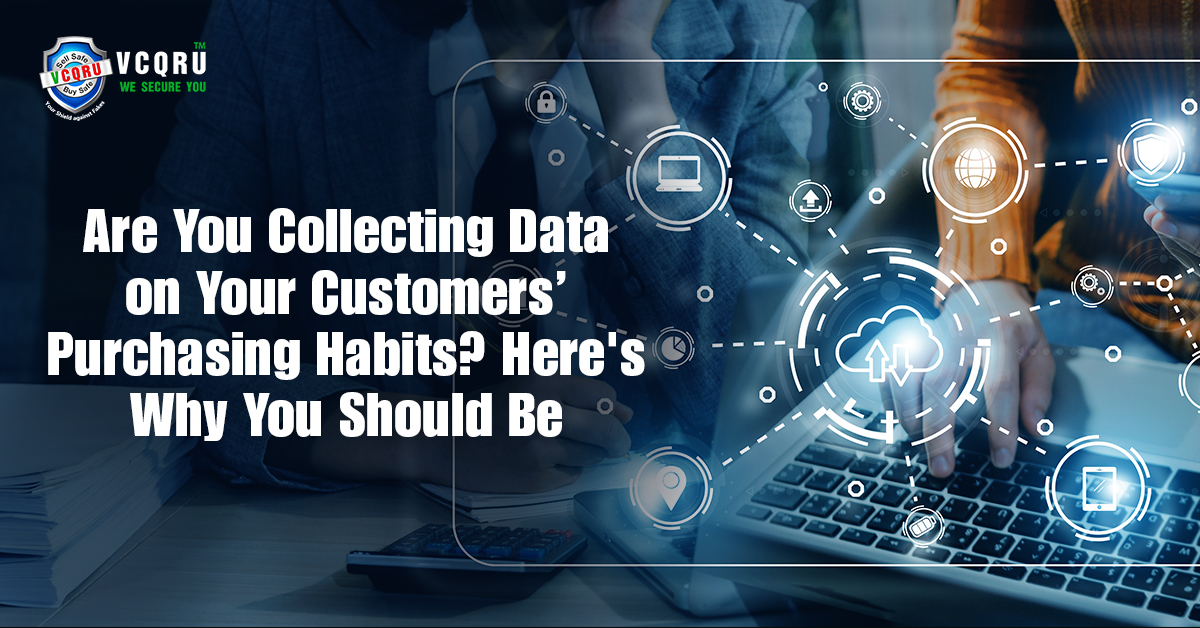Are You Collecting Data on Your Customers’ Purchasing Habits? Here's Why You Should Be
Jul 18, 2024

In a data-driven world, understanding your customers' purchasing habits is more crucial than ever because it is not just a competitive advantage it helps to boost your sales. Collecting and analyzing this data can provide deep insights into your customers' preferences, behaviors, and needs, enabling you to tailor your marketing strategies, improve customer experience, and ultimately drive sales. So, are you collecting data on your customers’ purchasing habits? If not, here’s why you should start now and how to do it effectively.
Understanding Customer Purchasing Habits
Purchasing habits refer to the patterns and behaviors that customers exhibit when they buy products or services. This includes:
Frequency of Purchases: How often a customer makes a purchase.
Average Spend: The average amount of money a customer spends per purchase.
Product Preferences: Which products or services a customer frequently buys.
Buying Channels: Where customers make their purchases—online, in-store, through mobile apps, etc.
Time of Purchase: The specific times or seasons when purchases are made.
The Importance of Customer Purchasing Data
Personalization and Improved Customer Experience
Tailored Recommendations: By understanding individual customer preferences, you can offer personalized product recommendations, which can significantly enhance the shopping experience. Personalized marketing leads to higher engagement and conversion rates. For instance, e-commerce giants like Amazon use sophisticated algorithms to suggest products based on past purchases.
Improved Customer Experience:
Data on purchasing habits can help you anticipate customer needs and preferences, allowing you to provide a more seamless and satisfying shopping experience. By use of purchasing data to segment your customers and create targeted marketing campaigns. Personalized emails, special offers, and tailored promotions can significantly improve engagement and conversion rates.
Inventory Management
Demand Forecasting: Knowing which products are popular helps in predicting future demand, ensuring that you maintain optimal stock levels and reduce instances of overstock or stockouts.
Product Development: Insights from purchasing data can inform which products are popular and which are not. This information can guide your product development efforts, helping you focus on creating items that meet your customers’ needs. And also help in preparing for peak periods, ensuring sufficient stock and resources to meet increased demand.
Customer Loyalty and Retention
Loyalty Programs: Data on purchasing habits can be used to design effective loyalty programs that reward customers based on their buying behavior. Offering points, discounts, or exclusive deals to frequent buyers fosters a sense of appreciation and loyalty.
Customer Feedback: Analyzing purchase patterns can help you identify satisfied and dissatisfied customers, enabling you to solicit feedback and address concerns promptly. Through this you can understand why customers might stop purchasing from you and develop strategies to retain them.
Pricing Strategies
Dynamic Pricing: Use purchasing data to implement dynamic pricing strategies. By understanding the price sensitivity of different customer segments, you can adjust prices to maximize sales and profits.
Promotions and Discounts: Identify the best times to run promotions or offer discounts. For example, if data shows that sales typically drop during certain periods, strategic discounts can help boost sales during those times.
Enhanced Customer Insights
Customer Profiles: Build detailed customer profiles that include demographic information, purchasing history, and preferences. These profiles are essential for personalized marketing and improving customer service.
Behavioral Trends: Identify trends in customer behavior, such as the types of products they buy together or their purchasing frequency. This information can be used to optimize your sales and marketing strategies.
Product Development and Improvement:
Identifying Gaps and Opportunities: Customer purchasing data can reveal gaps in your product offerings. For example, if customers frequently buy a specific product from a competitor, it might be worth considering adding a similar item to your inventory.
Enhancing Existing Products: Feedback and purchasing data can highlight areas where your products may need improvement, helping you stay competitive and meet customer expectations.
Marketing Strategies:
Targeted Campaigns: With detailed customer purchase data, you can create highly targeted marketing campaigns that appeal to specific segments of your audience, improving conversion rates.
Promotions and Discounts: Identifying trends in purchasing habits allows you to offer timely promotions and discounts on products that are in high demand or need a sales boost.
How to Collect Customer Purchasing Data
Point of Sale (POS) Systems
Modern POS systems are equipped with features that can track every transaction, providing detailed data on what products are sold, at what time, and by which customer.
Customer Relationship Management (CRM) Systems
CRM systems store detailed information about your customers, including their purchasing history that helps you build more effective customer relationships.
E-commerce Platforms
If you have an online store, your e-commerce platform can provide a wealth of data about customer purchasing behavior, such as browsing history, abandoned carts, and completed purchases.
Customer Loyalty Programs
Implementing a loyalty program not only incentivizes repeat purchases but also collects valuable data on customer buying patterns and preferences. These programs can track purchases and reward frequent buyers, providing valuable data on customer preferences and behavior.
Surveys and Feedback Forms
Directly ask your customers about their purchasing habits through surveys and feedback forms. Surveys can be conducted online, in-store, or via email.
Online Analytics Tools:
For tracking data of websites, there are multiple tools in the market on those one have Google Analytics that can track online purchasing behavior, providing insights into how customers navigate your website and which products they are interested in.
Social Media Insights:
Monitoring customer interactions on social media platforms can provide additional context to purchasing behaviors. Comments, likes, shares, and direct messages can all be valuable data points.
Best Practices for Data Collection
Respect Customer Privacy
Be transparent about data collection and ensure that you comply with data privacy regulations, such as GDPR or CCPA. Clearly communicate to your customers how their data will be used and obtain their consent that will help in building trust with your customers.
Data Security
Protect customer data by implementing robust security measures. This builds trust and ensures that your customers feel safe sharing their information.
Data Accuracy
Make sure your data is accurate by regularly cleaning and updating it. A lack of accurate data can result in poor marketing decisions.
Integrate Data Sources
Combine data from various sources (POS, CRM, web analytics, social media) to get a holistic view of customer purchasing behavior.
Analyze and Act
Data collection is only valuable if you act on the insights gained. Ensure you have the tools and expertise to analyze the data and derive actionable insights. These customer data insights will help to make informed business decisions.
Use Advanced Analytics
Employ data analytics tools and techniques such as machine learning and artificial intelligence to uncover deeper insights and trends that might not be immediately apparent.
Continuous Improvement
Make sure your data collection and analysis processes are regularly reviewed and refined. Customer preferences and market conditions change over time, so it's crucial to stay agile and adapt your strategies accordingly.
Leveraging Data on Purchasing Habits
Segmentation: Divide your customer base into segments based on their purchasing habits. Marketing efforts can be targeted more effectively this way.
Predictive Analytics: Use data to predict future purchasing behaviors and trends. Using this information can help you make better inventory decisions, develop marketing campaigns, and develop new products.
Cross-Selling and Upselling: Identify opportunities to recommend complementary or higher-value products to customers based on their purchase history.
Personalized Promotions: Offer personalized discounts and promotions to encourage repeat purchases and build customer loyalty.
Customer Journey Mapping: Understand the entire customer journey from initial interest to purchase, and identify key touchpoints where you can enhance the experience.
Collecting data on your customers’ purchasing habits is not just a trend; it’s necessary for transforming the way you do business. By understanding what drives your customers’ purchasing decisions, you can tailor your offerings, improve their experience, and ultimately drive growth and profitability for your business. However, it is essential to collect and use this data responsibly, ensuring transparency, security, and continuous improvement. Start leveraging the power of data today to stay ahead of the competition and build lasting relationships with your customers.


